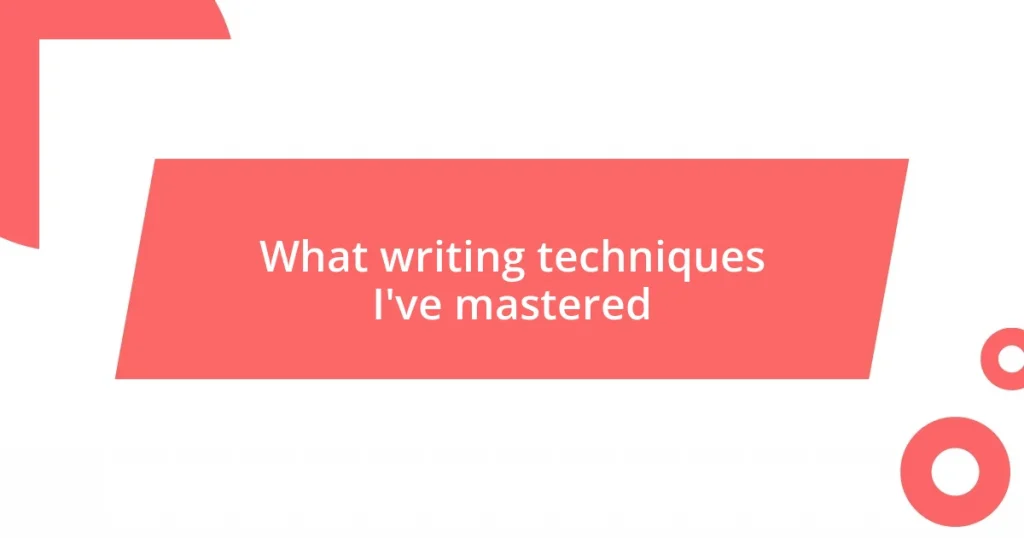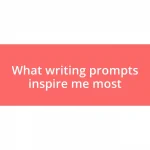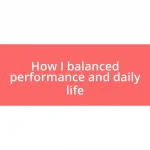Key takeaways:
- Authenticity and vulnerability in writing can forge genuine connections with readers.
- Techniques like showing rather than telling, varied sentence structure, and strong openings enhance storytelling impact.
- Effective editing, including reading aloud and seeking feedback, is essential for transforming drafts into polished works.

My writing journey insights
I remember when I first stumbled upon the world of writing—it felt like discovering a hidden treasure. The excitement and fear danced together; could I really put my thoughts into words that resonated? That moment sparked my journey, pushing me to explore my voice and the techniques that could transform my scattered ideas into something meaningful.
As I navigated through various styles, I realized that authenticity in writing is crucial. One day, after pouring my heart into a personal essay, a friend told me how my words struck a chord with her own experience. It dawned on me: my vulnerability could create connections. Isn’t it incredible how sharing our truths can foster understanding and empathy?
With time, I’ve learned the value of revision—it’s where the magic happens. I used to be hesitant about editing, feeling like it was an affront to my creativity. But now, I embrace the process, seeing it as an opportunity to refine my message. If I can reframe my perspective on feedback from critique to collaboration, why can’t others find freedom in the same practice? The journey is all about growth, isn’t it?
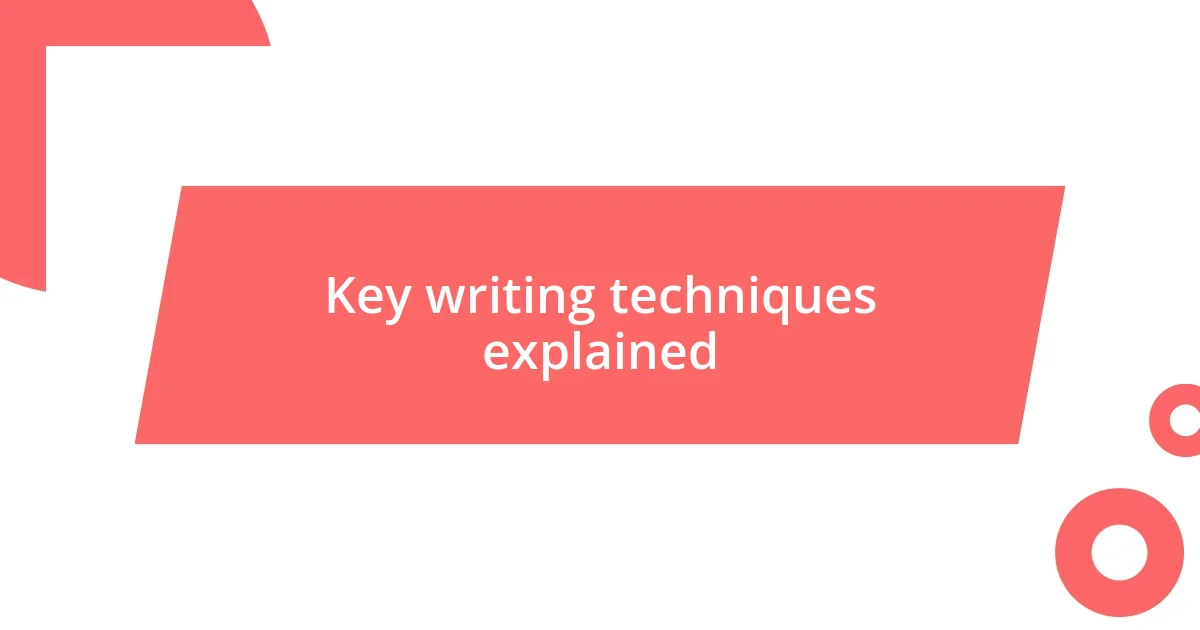
Key writing techniques explained
Key writing techniques can significantly enhance how we communicate our thoughts. One technique I’ve found particularly impactful is showing rather than telling. It’s like painting a vivid picture for the reader. I remember crafting a scene where a character felt anxious, and instead of stating it outright, I described her fidgeting fingers and darting eyes. That small shift transformed the narrative, pulling readers into the experience rather than leaving them as mere observers.
Here are some key techniques that I’ve mastered:
- Active Voice: Using an active voice makes writing more dynamic. It brings a sense of urgency and clarity.
- Imagery: Incorporating descriptive language can evoke emotions and create vivid scenes.
- Varied Sentence Structure: Mixing long and short sentences keeps the reader’s interest.
- Dialogue: Realistic dialogue can bring characters to life and make the story relatable.
- Strong Openings and Endings: A compelling hook grabs attention, while a satisfying conclusion leaves a lasting effect.
Each of these elements contributes to a more engaging and impactful piece. I’ve learned that the right technique can elevate a story from forgettable to unforgettable.
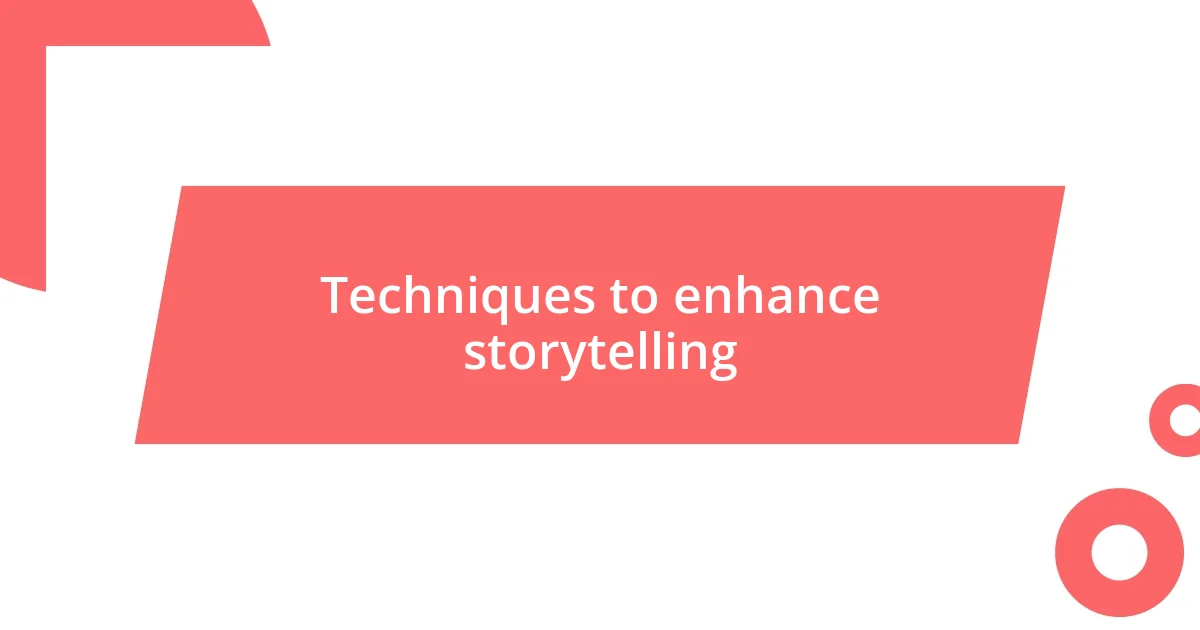
Techniques to enhance storytelling
To deepen the storytelling experience, I often employ the technique of building layered characters. It’s fascinating to see how adding depth to a character’s background can make them more relatable. I remember creating a protagonist who initially appeared a bit one-dimensional. However, when I introduced her childhood struggles and complex motivations, it not only enriched her development but also helped readers form a genuine bond with her. Have you ever encountered a character who left a lasting impression? That’s the power of empathy in storytelling.
Another technique that has enhanced my storytelling is the use of suspense. The thrill of anticipation keeps readers on the edge of their seats. I often take inspiration from my favorite novels, particularly during pivotal moments where I strategically hold back information. This approach was especially effective when I wrote a mystery story. By revealing clues bit by bit, I could feel the tension building, which kept readers eagerly turning pages. It’s exciting to think about how this technique transforms mundane narratives into captivating experiences.
Lastly, pacing plays a critical role in storytelling. Finding the right rhythm can be the difference between a gripping read and a tedious journey. I’ve realized that slowing down during emotional moments allows readers to savor the weight of what’s happening. Conversely, fast-paced action scenes can invigorate the narrative. I often recall one scene where I intentionally quickened the pace, and the adrenaline practically jumped off the page. Balancing these elements is crucial to maintaining engagement and evoking the desired emotions.
| Technique | Description |
|---|---|
| Layered Characters | Developing complex backstories to foster reader connection. |
| Suspense | Keeping readers guessing by revealing information gradually. |
| Pacing | Adjusting the rhythm of the story to enhance emotional impact. |
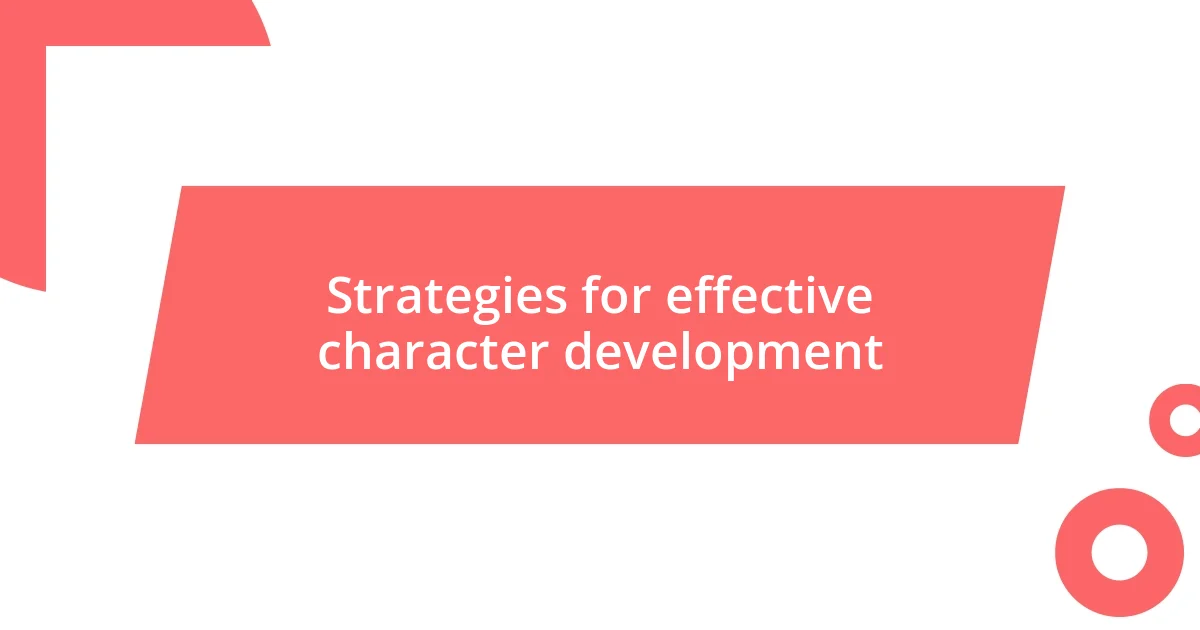
Strategies for effective character development
When it comes to effective character development, I’ve found that creating a relatable backstory is crucial. It’s interesting how a character’s past can shape their present actions and decisions. I once sketched out a character whose struggles with addiction profoundly influenced her behavior throughout the story. By weaving in her history, I noticed it became easier for readers to empathize with her, bridging an emotional gap that would have otherwise left them disconnected.
Another strategy that has really resonated with me is the use of internal conflict. This means showing a character grappling with their thoughts and feelings. I remember writing a scene where a hero stood at a crossroads, debating whether to stay loyal to a friend or pursue a greater good. Recognizing that the tension of such choices can be riveting, I let readers inside his head, revealing his fears and doubts. This not only made the character more complex but also enriched the narrative as readers felt the weight of his dilemma alongside him.
Lastly, I’ve embraced the idea of character evolution throughout the story. I always ask myself how characters can grow from their experiences. For instance, there was a character in one of my stories who started as a skeptic but gradually opened up to vulnerability after meaningful interactions with others. Watching him shed his old beliefs felt rewarding, and I believe it left a lasting impression on readers. Isn’t it inspiring when characters reflect real-life growth? The journey from one state of being to another makes for compelling storytelling, creating a resonant connection with the audience.
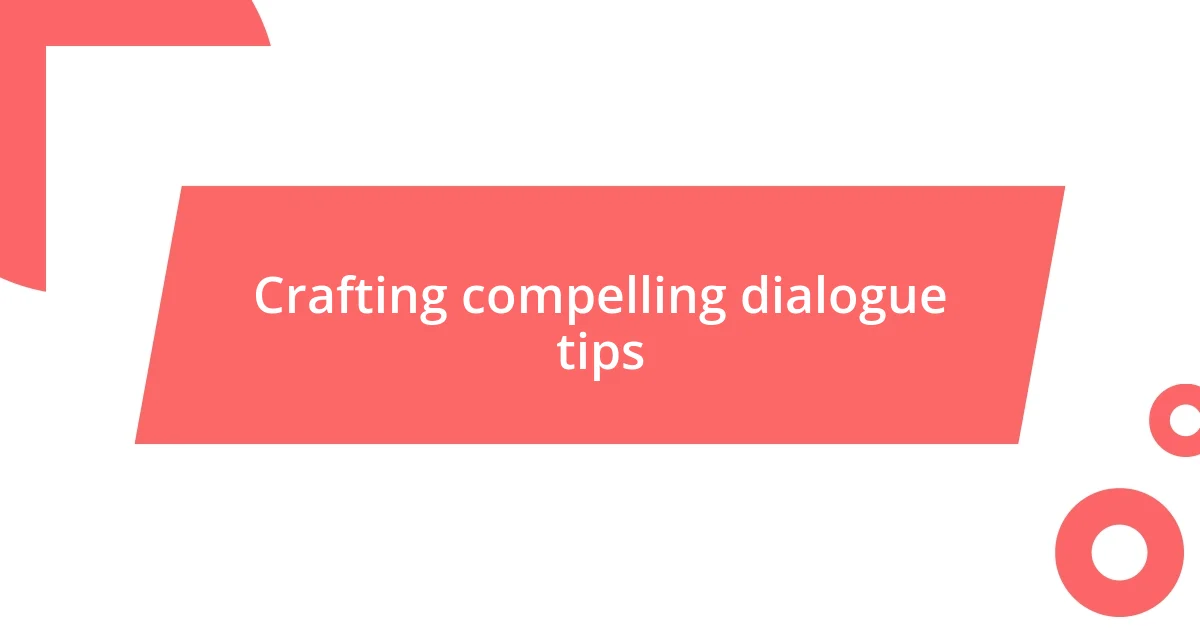
Crafting compelling dialogue tips
Crafting dialogue that feels real can be incredibly satisfying for both the writer and the reader. One technique I’ve mastered is to listen to how people talk in real life. Have you ever sat in a café and overheard snippets of conversation? Those little moments— the pauses, the interruptions, the slang—fill up my notebook now. When I implemented this in a story, I noticed how the characters sprang to life. They began to mirror the quirks and nuances of real conversation, making readers feel as though they were eavesdropping on genuine exchanges.
Another essential tip is to ensure each character has a distinct voice. I used to struggle with this until I started analyzing character traits. I remember crafting a sarcastic teen alongside a serious mentor figure. By giving them unique patterns of speech, I allowed their personalities to shine through. The teen might drop a witty one-liner, while the mentor offers a profound reflection. Mixing these tones creates a dynamic tension that keeps readers engaged. Don’t you find it interesting how a character’s way of speaking can paint an entire picture of who they are?
The use of subtext is an art form in itself. I find that what isn’t said often carries more weight than the words chosen. There was a scene in my last story where two characters avoided discussing a painful truth. The tension was palpable, and readers could feel the unsaid thoughts lingering in the air. This layered dialogue added depth and encouraged them to reflect on their own experiences. Have you ever related to a moment when you felt more than could be expressed? That’s the magic of subtext—it’s an invitation for readers to immerse themselves in the character’s emotional world.
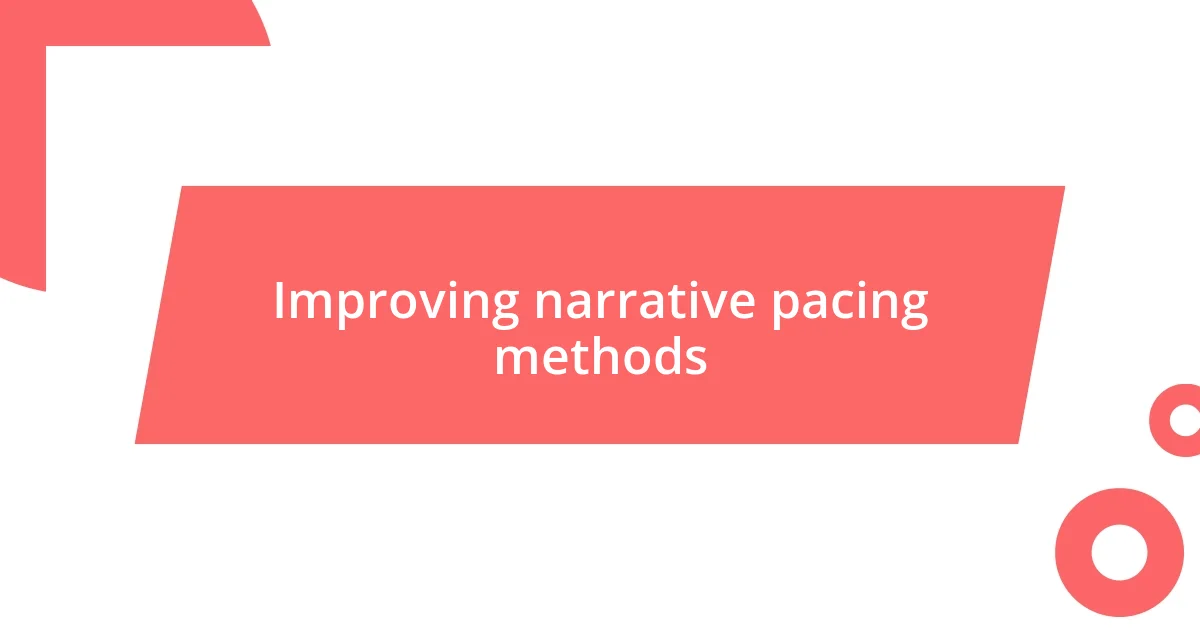
Improving narrative pacing methods
Improving narrative pacing methods
One approach I’ve found effective for honing narrative pacing is varying the length of my sentences. When I wrote a suspenseful chase scene, I deliberately used shorter sentences to create that adrenaline rush and urgency. I discovered that this technique can have a dramatic effect on how readers experience tension. Don’t you think that rhythm can truly drive a reader’s heart rate up?
Another method I’ve embraced is the strategic placement of pacing breaks—those moments when the story eases up to give readers a breather. I recall writing a pivotal scene where the protagonist faces a crisis. I intentionally included a reflective moment afterward, allowing both the character and the reader to gather their thoughts. This not only enriched character depth but also offered readers a chance to process the events. Have you ever felt overwhelmed in a story, only to appreciate when it slows down?
Additionally, I’ve learned that knowing when to cut details is vital. I once wrote a scene filled with intricate descriptions that I thought added depth. But as I revisited it, I realized some parts were dragging the pacing down. By trimming unnecessary details, the action felt more immediate and engaging. Isn’t it fascinating how less can be more in storytelling? Finding that balance may lead to a smoother reading experience that keeps your audience wanting more.

Editing techniques for polished drafts
Editing is a crucial stage in transforming a draft into a polished piece. One technique I’ve mastered is reading my work aloud. I vividly remember a time when I was preparing my first short story for submission. As I read each line, certain awkward phrases jumped out at me. The auditory experience highlighted clunky transitions and forced dialogue that I might have missed while reading silently. Have you ever noticed how hearing your words can reveal flaws you didn’t catch on the page?
Another effective editing strategy revolves around taking a break before revisiting my drafts. After I finish writing, I step away for at least a day. This distance gives me a fresh perspective, allowing me to spot inconsistencies and overused phrases. I once returned to a piece that I thought was complete, only to realize I had repeated “very” multiple times. It’s moments like these that remind me how our minds can overlook things when we’re too close to the work. Doesn’t that sense of clarity feel almost like a breath of fresh air?
Lastly, I find value in seeking feedback from trusted peers. There’s something incredibly enlightening about another set of eyes scrutinizing my writing. I remember sending a draft to a fellow writer who pointed out a character’s motivation that I hadn’t clearly conveyed. This exchange not only improved my draft but reminded me of the importance of collaboration in the writing process. Have you ever felt the spark of inspiration from someone else’s insights? It’s truly remarkable how shared perspectives can elevate our work.










